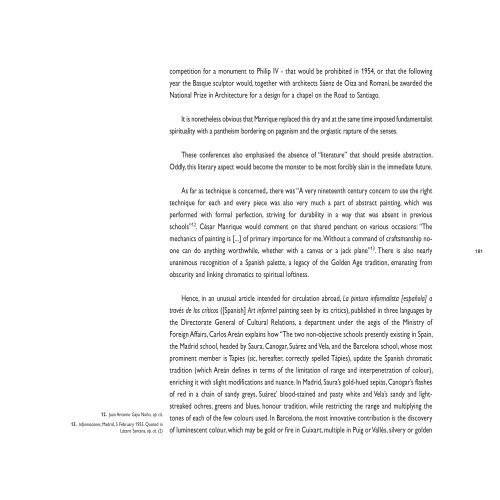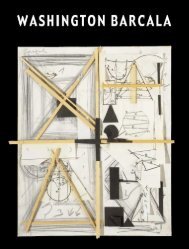VERSIÓN INGLESA ENGLISH VERSION - Fundación César Manrique
VERSIÓN INGLESA ENGLISH VERSION - Fundación César Manrique
VERSIÓN INGLESA ENGLISH VERSION - Fundación César Manrique
You also want an ePaper? Increase the reach of your titles
YUMPU automatically turns print PDFs into web optimized ePapers that Google loves.
12. Juan Antonio Gaya Nuño, op. cit.<br />
13. Informaciones, Madrid, 5 February 1955. Quoted in<br />
Lázaro Santana, op. cit. (2)<br />
competition for a monument to Philip IV - that would be prohibited in 1954, or that the following<br />
year the Basque sculptor would, together with architects Sáenz de Oiza and Romaní, be awarded the<br />
National Prize in Architecture for a design for a chapel on the Road to Santiago.<br />
It is nonetheless obvious that <strong>Manrique</strong> replaced this dry and at the same time imposed fundamentalist<br />
spirituality with a pantheism bordering on paganism and the orgiastic rapture of the senses.<br />
These conferences also emphasised the absence of “literature” that should preside abstraction.<br />
Oddly, this literary aspect would become the monster to be most forcibly slain in the immediate future.<br />
As far as technique is concerned,. there was “A very nineteenth century concern to use the right<br />
technique for each and every piece was also very much a part of abstract painting, which was<br />
performed with formal perfection, striving for durability in a way that was absent in previous<br />
schools” 12 . <strong>César</strong> <strong>Manrique</strong> would comment on that shared penchant on various occasions: “The<br />
mechanics of painting is [...] of primary importance for me. Without a command of craftsmanship noone<br />
can do anything worthwhile, whether with a canvas or a jack plane” 13 . There is also nearly<br />
unanimous recognition of a Spanish palette, a legacy of the Golden Age tradition, emanating from<br />
obscurity and linking chromatics to spiritual loftiness.<br />
Hence, in an unusual article intended for circulation abroad, La pintura informalista [española] a<br />
través de los críticos ([Spanish] Art informel painting seen by its critics), published in three languages by<br />
the Directorate General of Cultural Relations, a department under the aegis of the Ministry of<br />
Foreign Affairs, Carlos Areán explains how “The two non-objective schools presently existing in Spain,<br />
the Madrid school, headed by Saura, Canogar, Suárez and Vela, and the Barcelona school, whose most<br />
prominent member is Tapies (sic, hereafter, correctly spelled Tàpies), update the Spanish chromatic<br />
tradition (which Areán defines in terms of the limitation of range and interpenetration of colour),<br />
enriching it with slight modifications and nuance. In Madrid, Saura’s gold-hued sepias, Canogar’s flashes<br />
of red in a chain of sandy greys, Suárez’ blood-stained and pasty white and Vela’s sandy and lightstreaked<br />
ochres, greens and blues, honour tradition, while restricting the range and multiplying the<br />
tones of each of the few colours used. In Barcelona, the most innovative contribution is the discovery<br />
of luminescent colour, which may be gold or fire in Cuixart, multiple in Puig or Vallés, silvery or golden<br />
181
















![Becas y premios de la Fundación César Manrique [1997-2006]](https://img.yumpu.com/20766851/1/184x260/becas-y-premios-de-la-fundacion-cesar-manrique-1997-2006.jpg?quality=85)
